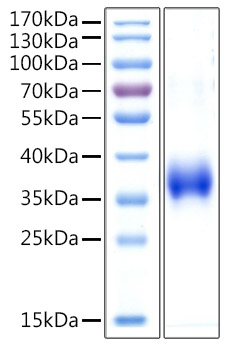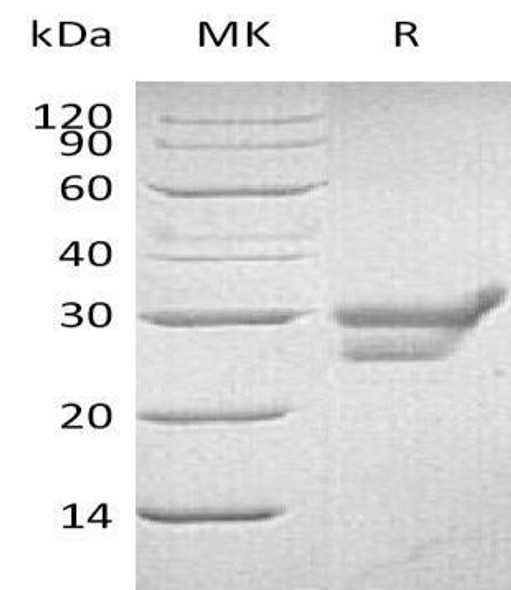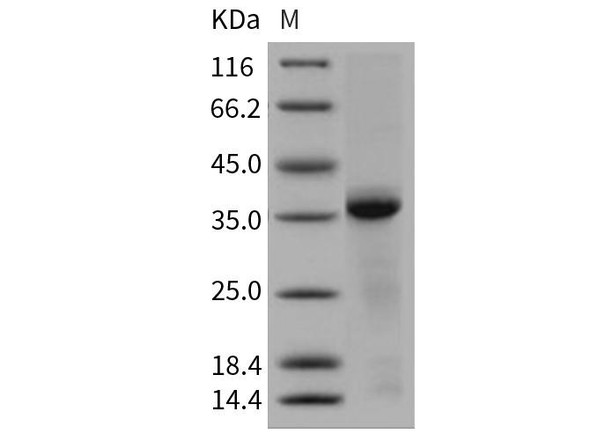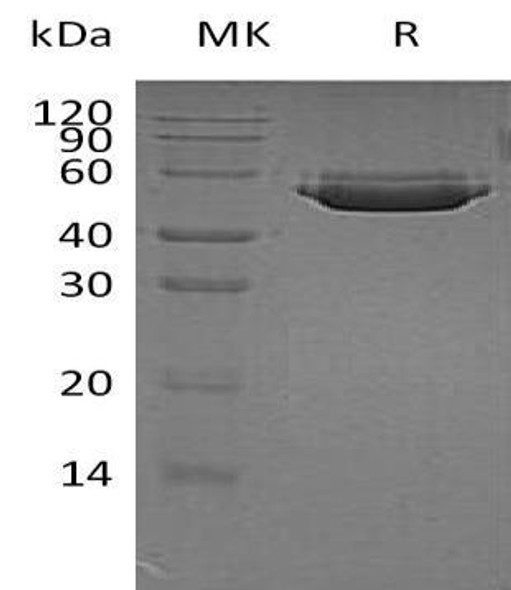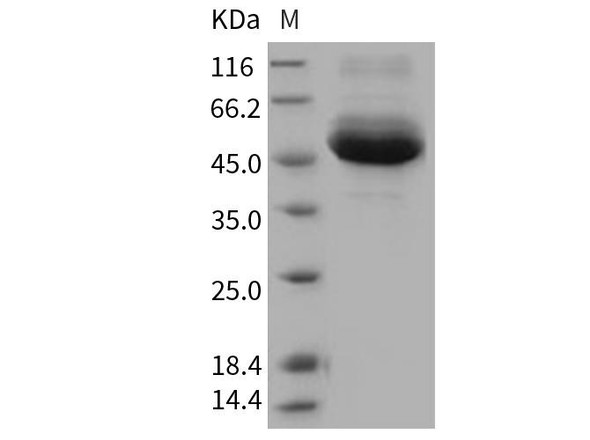Description
Recombinant Human Cathepsin L Protein
The Recombinant Human Cathepsin L Protein is a biologically active recombinant protein that plays a significant role in various cellular processes and signaling pathways in human biology. This protein is widely employed in immunological research, cell biology studies, protein-protein interaction analyses, and therapeutic development, providing researchers with a reliable tool for investigating Cathepsin L function and its implications in health and disease.
This product (SKU: RPCB1760) is produced using HEK293 Cells and features a C-His tag for convenient detection and purification. The protein exhibits a calculated molecular weight of 37.3 kDa with an observed molecular weight of 37 kDa under denaturing conditions, achieving ≥ 90 % as determined by SDS-PAGE., ensuring exceptional quality and consistency for research applications.
Key Features
| High Purity by Affinity Chromatography | |
| Mammalian & Bacterial Expression Systems | |
| High lot-to-lot consistency via strict QC |
| Product Name: | Recombinant Human Cathepsin L Protein |
| SKU: | RPCB1760 |
| Size: | 50 μg |
| Reactivity: | Human |
| Synonyms: | Procathepsin L, 3.4.22.15, Cathepsin L1, Major excreted protein, MEP, CTSL |
| Tag: | C-His |
| Expression Host: | HEK293 Cells |
| Calculated MW: | 37.3 kDa |
| Observed MW: | 37 kDa |
| Gene ID: | 1514 |
| Protein Description: | High quality, high purity and low endotoxin recombinant Recombinant Human Cathepsin L Protein (RPCB1760), tested reactivity in HEK293 Cells and has been validated in SDS-PAGE.100% guaranteed. |
| Endotoxin: | < 1 EU/μg of the protein by LAL method. |
| Purity: | ≥ 90 % as determined by SDS-PAGE. |
| Formulation: | Lyophilized from a 0.22 μm filtered solution of 50 mM NaAc, 100 mM NaCl, pH 7.5. |
| Reconstitution: | Centrifuge the vial before opening. Reconstitute to a concentration of 0.1-0.5 mg/mL in sterile distilled water. Avoid vortex or vigorously pipetting the protein. For long term storage, it is recommended to add a carrier protein or stablizer (e.g. 0.1% BSA, 5% HSA, 10% FBS or 5% Trehalose), and aliquot the reconstituted protein solution to minimize free-thaw cycles. |
| Storage: | Store at -20℃.Store the lyophilized protein at -20℃ to -80 ℃ up to 1 year from the date of receipt. After reconstitution, the protein solution is stable at -20℃ for 3 months, at 2-8℃ for up to 1 week. |
Cathepsin L is a lysosomal cysteine protease that plays a major role in intracellular protein catabolism, and is potent in degrading collagen, laminin, elastin, as well as alpha-1 protease inhibitor and other structural proteins of basement membranes. It is secreted by liver flukes at all stages of their development in the mammalian host, are believed to play important roles in facilitating parasite migration (tissue degradation), feeding and immuno-evasion. Like many proteases, Cathepsin L is synthesized as an inactive preproenzyme, and cleavage of the 96-residue proregion is necessary to generate the fully active 221-residue mature enzyme. Studies have demonstrated that cleavage of the proregion occur autocatalytically under acidic conditions. The enzyme takes part in nutrient acquisition by catabolizing host proteins to absorbable peptides, facilitates the migration of the parasite through the host intestine and liver by cleaving interstitial matrix proteins such as fibronectin, laminin and native collagen and is implicated in the inactivation of host immune defenses by cleaving immunoglobulins. Recently, Cathepsin L has been shown to suppress Th1 immune response in infected laboratory animals making them susceptible to concurrent bacterial infections. Cathepsin L is synthesized in large amounts and secreted by many malignantly transformed cells, and induced by growth factors and tumor promoters. In addition to its role in protein degradation, evidence has accumulated for the participation of Cathepsin L in various physiological and pathological processes, such as tumor invasion and metastasis, bone resorption, spermatogenesis, and arthritis. Accordingly, Cathepsin L may prove useful as a diagnostic or prognostic marker of human tumor malignancy.


